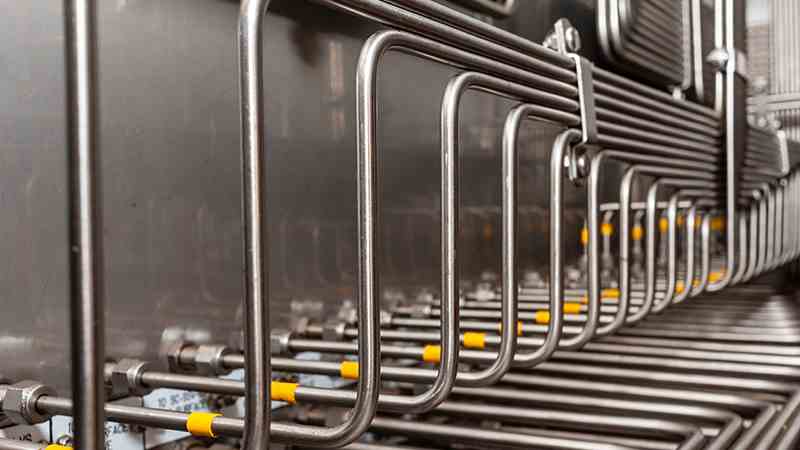The Risk
Hydraulic fluid systems use extreme pressures anywhere from 2,000 to 3,000 psi. When a failure in the system causes a breach such as a cracked pipe joint or ruptured hose. The pressurized hydraulic fluid escapes at such high velocities that it usually becomes atomized into an extremely flammable and potentially explosive mist.
Since conventional hydraulic fluid is a petroleum oil it can be difficult to extinguish and further poses a serious hazard to both life and property once ignited. In the article Fire Hazards of Hydraulic Fluid written by The Great American Insurance Group it explains that: “Hydraulic fluids may form dangerous mists or sprays from small leaks in hydraulic systems at pressures as low as 250 psi. Instances of sprays reaching 40-50 feet from the point of origin have been reported. Such a spray may become a huge torch if ignited by any source in the area.”
Hydraulic System Fire Mitigation
While this article does focus on fire suppression for hydraulic systems, we want to first list a few key points to mitigate or even prevent these types of fires:
Maintenance and Support
Routine hydraulic system maintenance is key to preventing many issues, including fire. Inspecting equipment, joints, hoses. Making sure all components are adequate for the pressures being used. Inspecting fluid looking for contamination or thermal breakdown. Detecting leaks and keeping all equipment and surrounding areas clean from fluid. The main cause of hydraulic system failures and leaks is due to excessive vibration. Thus, keeping the system rigidly supported and minimizing vibration will lower the risk of a failure and fire.
Maintenance should be performed in a regularly scheduled routine.

Removing Sources of Ignition
Removing all sources or potential sources of ignition from the area of the hydraulic system may seem like a “no-brainer”. However, this step should be considered carefully because not all “sources of ignition” are obvious. For example, many oil-based fires are caused by ball bearing failure, i.e. ball bearings going out and overheating. Of course, don’t forget to remove those obvious sources if possible, like open flames and equipment that causes electrical arcs.
Another consideration is the distance hydraulic fluid can travel. Since hydraulic fluid is usually under great pressure when a system has a failure. Some have underestimated the distance the fluid can travel, especially if the fluid becomes atomized and turns into a mist or vapor. For these reasons and more removing potential sources of ignition is really a step that may seem simple, but really should be well thought out.
Replacing Conventional Fluid with Less-Combustible Fluid
While petroleum-based or mineral hydraulic fluid has several benefits, it is used in most hydraulic systems for one main reason, cost. Thus, equipment manufacturers have generally chosen less-combustible fluids for specific applications. It should be noted however that non-combustible or probably more accurate “less-combustible” hydraulic fluid is an option and can be used to greatly reduce the risk of a hydraulic system fire. While less-combustible fluids reduce the risk of fire or explosion, no hydraulic fluid is completely non-flammable. Even rated FRHF (Fire Resistant Hydraulic Fluids) will burn under certain conditions.
Another big downside to most less-combustible fluids is that they do not provide as much lubrication as petroleum-based fluids. As a result, they end up causing more maintenance and corrosion throughout the system since they can swell or dissolve gaskets and hoses. They can even potentially corrode certain metals. Even further, switching to this type of fluid presents further likely costs in equipment modification and may even void any equipment warranties available. (It is highly recommended to speak to the equipment manufacturer first before switching to this type of fluid from conventional fluids.)
Fire Suppression for Hydraulic Systems
Sometimes even when you do everything right, everything wrong still happens. Having a backup plan to mitigate a hydraulic system fire is a very wise course because they can very quickly get and of hand. In fact, the explosion potential of hydraulic system fires can cause major property damage, physical injures, and even death.
Cease Fire has developed an automatic, self-contained, heat activated system that will protect and preserve valuable life and property should all the wrong things happen during a hydraulic system failure. Cease Fire’s patented “dual agent” technology combines its ABC powder with DuPont’s FE 227 EPA approved fire extinguishing cleaning agent to create a dual agent gel that provides a much more efficient fire suppression system for hydraulic system fires.
It automatically works due to the built in sensors that detect fire and in turn sends a signal to the Cease Fire suppression system. This in turn triggers the unit, which immediately reacts, suppressing the fire in four to five seconds. The fire is suppressed by both the FE 227 gas and the unique ABC powder. The powder settles in the area to prevent reigniting of the fire.
In Closing
As a standalone fire suppression system, the Cease Fire CFF 800 will provide over twelve years of fire protection with a minimal amount of care. Cease Fire's powerful formula is delivered in the industry's only truly modular system. Each unit is completely self-contained and pre-engineered. As such, the Cease Fire CFF 800 is one of the most cost-effective fire suppression solutions available and has further been tested and approved by UL. If you want to know more about choosing the right solution for your hydraulic system, reach out to Cease Fire at 1-(888)-232-7334.


